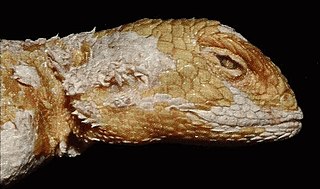
Agama is the name of a genus of small-to-moderate-sized, long-tailed, insectivorous Old World lizards, and also is one of their common names. The genus Agama includes at least 37 species in Africa, especially sub-Saharan Africa, where most regions are home to at least one species. Eurasian agamids are largely assigned to genus Laudakia. The various species differ in size, ranging from about 12 to 30 centimetres in length, when fully grown.

Tropiocolotes is a genus of geckos, lizards in the family Gekkonidae. The genus is native to North Africa and the Middle East. Species in the genus Tropiocolotes grow to a total length of about 2 in (5.1 cm). They are commonly known as dwarf geckos, pygmy geckos, or sand geckos. They have an elongated body and the head is oval and of equal or lesser width than the body.

Laudakia is a genus of lizards, commonly known as Asian rock agamas, in the family Agamidae. The genus is endemic to Asia.

The Sinai agama is an agamid lizard found in arid areas of southeastern Libya, eastern Egypt, Israel, Jordan, Syria, Saudi Arabia, the United Arab Emirates, Oman, eastern Sudan, Ethiopia, Eritrea, and Djibouti.

The genus Cordylus includes a wide variety of small- to medium-sized spiny lizards from Africa, collectively called girdle-tailed or girdled lizards. All are diurnal and ovoviviparous. Most species are rupicolous (rock-dwelling), while a few species are arboreal or live in burrows. They defend themselves with osteoderms and by quickly retreating into rock crevices or burrows. Many species live in groups and males defend territories.
Acontias is a genus of limbless skinks, the lance skinks, in the African subfamily Acontinae. Most are small animals, but the largest member of the genus is Acontias plumbeus at approximately 40 cm (16 in) snout-vent length. All members of this genus are live-bearing sandswimmers, with fused eyelids. A recent review moved species that were formerly placed in the genera Typhlosaurus, Acontophiops, and Microacontias into this genus, as together these form a single branch in the tree of life. This new concept of Acontias is a sister lineage to Typhlosaurus, and these two genera are the only genera within the subfamily Acontinae.

Latastia is a genus of lizards of the family Lacertidae. Species of this genus are distributed in Africa but one subspecies lives in Yemen. Collectively, they are known as long-tailed lizards.

Philochortus is a genus of lizards of the family Lacertidae. Species of this genus are distributed in Egypt, Algeria, Libya, Mali, Niger, Ethiopia, Djibouti, Eritrea, Somalia, Kenya, Yemen, and Saudi Arabia.

The Agaminae are a subfamily of reptiles in the family Agamidae.

The shield-tailed agama, also known commonly as the dwarf shield-tailed agama, Taylor's strange agama, and the turnip-tailed agama, is a species of lizard in the family Agamidae. The species is endemic to the Horn of Africa.

Stellagama is a monotypic genus of agamid lizard, containing the single species Stellagama stellio, also known as the starred agama or the roughtail rock agama.

The common agama, red-headed rock agama, or rainbow agama is a species of lizard from the family Agamidae found in most of sub-Saharan Africa. To clear up historical confusion based on Linnaeus and other authors, Wagner, et al. (2009) designated a neotype for the species, using a previously described specimen from Cameroon in the collection of the Zoologisches Forschungsmuseum Alexander Koenig in Bonn. The species name was formerly applied to a paraphyletic collection of taxa, and mitochondrial DNA analysis of various populations indicates they represent separate species., Consequently, three former subspecies A. a. africana, A. a. boensis, and A. a. mucosoensis are now considered separate species, and A. a. savattieri is considered synonymous with A. africana.

Agama rueppelli, commonly known as the arboreal agama or Rüppell's agama, is a species of lizard in the family Agamidae. The species is endemic to East Africa.
Agama robecchii, commonly known as Robecchii's agama, is a species of lizard in the family Agamidae. The species is endemic to the Horn of Africa.
Hemidactylus fragilis is a species of gecko, a lizard in the family Gekkonidae. The species is indigenous to the Horn of Africa.
Acanthocercus guentherpetersi, Peter's ridgeback agama, is a species of lizard in the family Agamidae. It is a small lizard found in Ethiopia.
Acanthocercus minutus, the blue-headed tree agama, black-necked agama, southern tree agama, or blue-throated agama, is a species of lizard in the family Agamidae. It is a small lizard found in Ethiopia and Kenya.

The Vaillant’s strange agama, shield-tail agama or turnip-tail agama, is a species of lizard in the family Agamidae. The species is endemic to the Horn of Africa.
Wilms's agama, shield-tail agama or turnip-tail agama, is a species of lizard in the family Agamidae. The species is endemic to the Horn of Africa.
The Ethiopian ridgeback agama , is a species of lizard in the family Agamidae. The species is endemic to the Horn of Africa. It is among the largest species of Xenagama, with snout-to-vent length of males up to 84.5mm.











